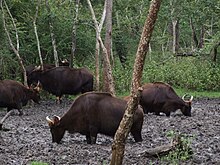Mineral lick: Difference between revisions
Bruinfan12 (talk | contribs) links... |
|||
| Line 7: | Line 7: | ||
[[Image:salt_lick_01.jpg|thumb|Block of salt mounted on a post]] |
[[Image:salt_lick_01.jpg|thumb|Block of salt mounted on a post]] |
||
People use salt licks to attract or maintain wildlife, whether it be for viewing, photography or hunting purposes. |
People use salt licks to attract or maintain wildlife, whether it be for viewing, photography, farming, or hunting purposes. |
||
==Mythology== |
==Mythology== |
||
Revision as of 21:07, 20 May 2010

A salt lick is a salt deposit that animals regularly lick. In an ecosystem, salt/mineral licks often occur naturally, providing the sodium, calcium, iron, phosphorus and zinc required in the springtime for bone, muscle and other growth in deer and other wildlife, such as moose, elephants, cattle, woodchucks, domestic sheep, fox squirrels, mountain goats and porcupines. Harsh weather exposes salty mineral deposits that draw animals from miles away for a taste of needed nutrients.
Artificial salt licks

People use salt licks to attract or maintain wildlife, whether it be for viewing, photography, farming, or hunting purposes.
Mythology
In Norse mythology, before the creation of the world, it was the divine cow Audhumla who, through her licking of the cosmic salt ice, gave form to Buri, ancestor of the gods and grandfather of Odin. On the first day as Audhumla licked, Buri's hair appeared from the ice, on the second day his head and on the third his body.[1]
References
Further reading
- Kurlansky, Mark (2002). Salt: A World History.Walker and Co. ISBN 0-8027-1373-4.
